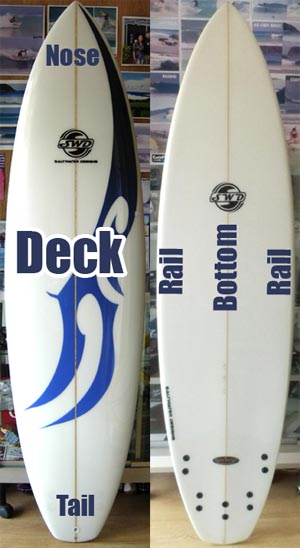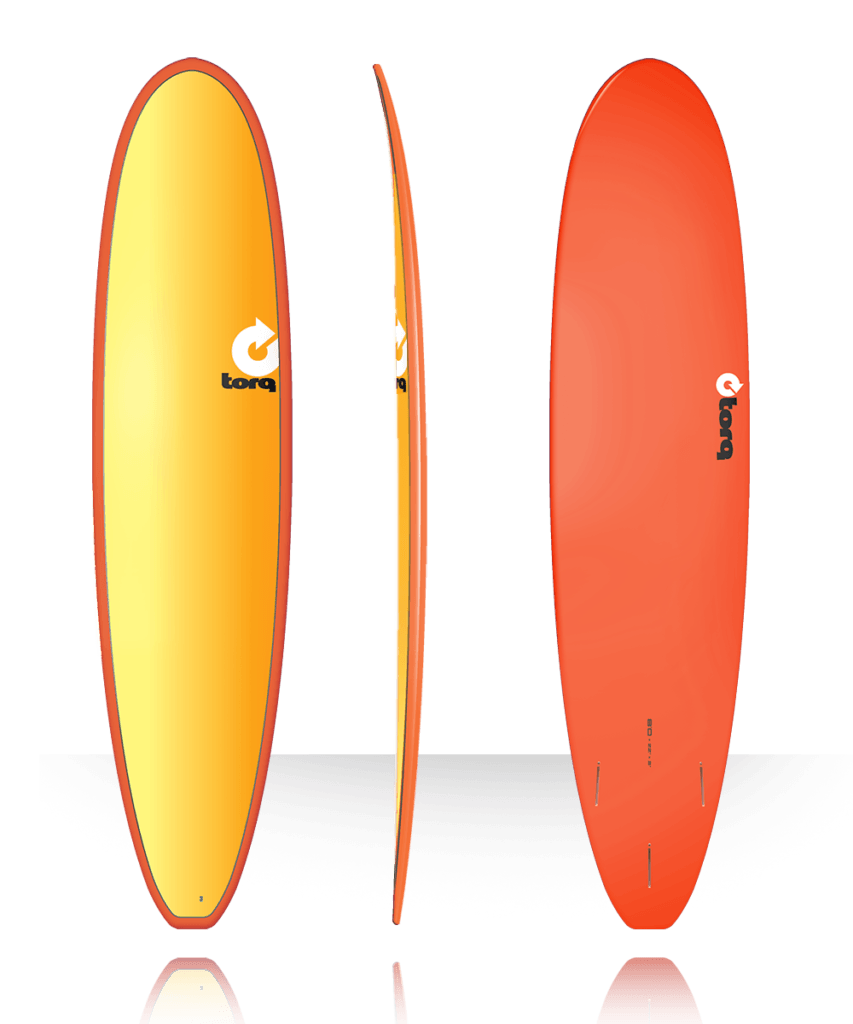Choosing the Right Surfboard for Learning to Surf
It's probably handy to be familiar with what the parts of a surfboard are called first.

Parts of a Surfboard
- The nose is the front of the surfboard
- The tail is the back end of the surfboard
- The deck is where you put wax and stand
- The rocker, is the curve of the surfboard from nose to tail
- Channels, or Concaves, are the curves on the bottom from rail to rail
- Sharp things near the tail are the fins
- The stringer is the piece of thin wood running down the center of the surfboard
General Tips on Buying your First Surfboard
When you first start surf boarding, start off by borrowing your friends surfboard or rent a board. Borrowing and renting has the added advantage of being able to try a few different surfboards before you commit to buying something.
Find a surf shop in your area that rents surfboards. A few dollars spent at this stage is worth it, because it will ensure you will find the right surfboard for you.
When choosing a surfboard don't be influenced by looks. Choose something big and fat. Looking cool in the water comes later. There's is nothing more uncool than someone learning to surf on a high performance shortboard, unable to catch waves or stand up.
A little time spent on a bigger surfboard in the beginning will help you to progress much faster.

Many budding surfers start by practicing on soft top surfboards for a few weeks until they are confident about catching waves and standing up. Then moving on to a hard surfboard.
If you must buy one, look for a used board when first starting out. Most surf shops should have some sort of used board selection. Look in newspapers, or internet for surfboards for sale.
Fiberglass or Epoxy?
The other thing you need to be aware of is, what the surfboard is made from. Most pro and experienced surfers prefer to ride fiberglass, but fiberglass surfboards need a bit more care. Fiberglass surfboards are quite fragile compared to epoxy and a bump on the wall on your way out can cause the fiberglass to crack and bring your surf trip to a halt. It is best to leave fiberglass boards for later when you start to improve handling your board, in and out of the water.
Epoxy surfboards are strong and are a bit more forgiving if you accidentally bump your board on the door when rushing to get to the beach. Epoxy can break too, but they are definitely much stronger, they also float better, giving you a slight advantage when paddling.
Surfboard Size
Generally
| Your Weight | Surfboard Size |
|---|---|
| 120lb - 55kg | 6'8" - 6'10" |
| 140lb - 63kg | 6'10 - 7'2" |
| 170lb - 77kg | 7'2 - 7'6" |
| 190lb - 84kg and above | 7'6 - 8'0 |
The sizes above are for the first surfboard you will buy. When initially learning, the surfboard should be at least 12 inches longer than yourself.
When you are more experienced a good surfboard size rule of thumb is the surf board should be 6 inches taller than you. Of course your weight will influence the size of your surfboard and varying the length by 1-2 inches and increasing the thickness and/or width will compensate for a full bodied surfer.
Nowadays experienced surfers are riding surfboards a few inches shorter than their height. This enables tight turns in the pocket of the wave. There are also many shapes that are short and wide and so still have plenty of float. All these new shapes and designs have created a need for people to know the volume (how many litres of water the surfboard would displace). It can be very deceptive that a chunky 5 foot 6 inch board could have the same volume as a standard 6'8 shortboard.
A longboard, a round-nosed board of 9' or more length, is too difficult to control for most beginners, while a shortboard is typically too thin, narrow, and short, making it unstable and difficult to paddle and catch waves.
Below are 2 styles of surfboards we feel are great options for a first surfboard for a beginner

Minimals (mini malibu)
These are by far the best learning to surf surfboard. They are typically around the 7'2" to 8'0" they have the shape of a longboard with a rounded nose and some extra width up to around 22" inches wide.
They are easy to paddle and catch waves and the extra width makes them quite stable for standing up. The minimal's shorter length also makes them a bit easier to maneuver in the water, than a longboard.
Paddling out through the waves will require you to do a turtle roll rather than duck diving though.
Don't worry about duck diving at this stage just get the right board for learning.
Hybrid or Funboard
Second choice would be a hybrid board. A hybrid surfboard is characterised by being a little wider through the nose curve and having a little extra thickness.
They are easy to paddle and are great wave catchers. They are not quite as stable for standing up, as a longboard, but definitely much more stable than a shortboard.
The beauty of a hybrid is that the tail shapes are closer to a shortboard, so that when you get better and are ready to do turns, you can step back on the tail and turn the board.
They usually range in length from 6'8" to around 7'6", but you will see many hybrid shapes outside of these lengths.
Second Hand
Be sure to look the board over before you buy. Check for dings, cracks, holes, anything that may need to be repaired before you go surfing. Test for delaminations, soft and bubbly areas usually on the deck, yellowing an indication of water inside. Delaminations and yellowing could also be a sign of the surfboard being left in a hot place or directly in the sun for long periods. Both will weaken the board and allow it to take on water. How to repair dings, or holes in the board
Make sure the fins are intact and that there is a plug on the deck for a leash. Again, look for something with general characteristics of being wide, thick, and long as opposed to narrow, short, and thin. The board need not be totally pristine; once you really get into surfing you'll likely want to upgrade to something different.New
For a first new surfboard. Go to a surf shop that is run by someone who is an experienced surfer. They will be able to give the right advice on which surfboard is right for you.
Bic surfboards are popular first surfboards. They are aimed at the beginner market being strong and with a wide range of minimals and hybrid shapes. Another great brand which is new on the market, but already proving to be a great first surfboard and also for more experienced surfers is TORQ Surfboards. You should be able to find one of these brands in your local surf shop.

Another choice is a shaped epoxy board. Shaped epoxy surfboards are stronger than fiberglass, but have more defined shapes than NSP or Bic.
The point here is strength, as learning to surf also involves learning to handle your surfboard, in and out of the water.
Bumping your surfboard on the door on the way out can bring that surf trip to a fast halt, as a fiberglass surfboard is fragile and will probably need to be repaired before going in the water.
Ready For An Upgrade?
So you've gone out, bought a longboard, hybrid, minimal... been surfing for a while and think it's time to get something shorter.
Don't buy anything until you have tried out a few different surfboards first. Look for a surf shop that has a good range of rental surfboards. If you rush out and get something too short, you will regret it.
You might find that all you really want is the same as what you already have, with a little bit more performance characteristics.
Be patient, put your ego away, practice, practice, practice and have fun
Next >>> Surfing Rules/Etiquette
Read More About Caring for your surfboard
Other FAQs
